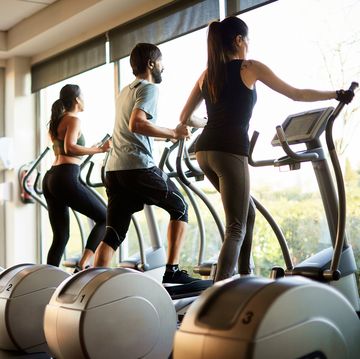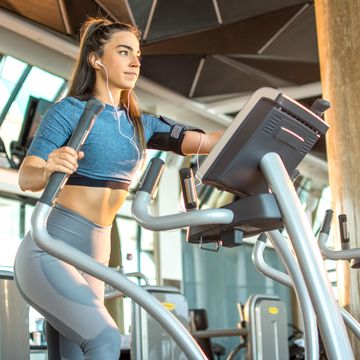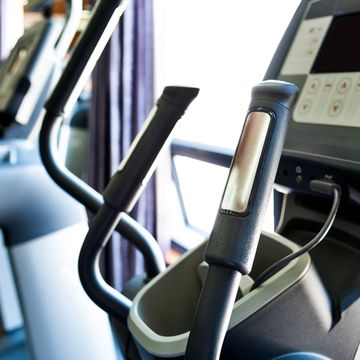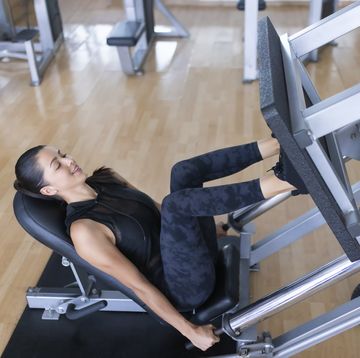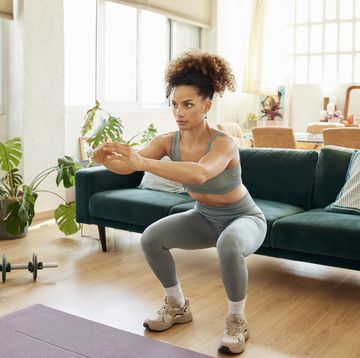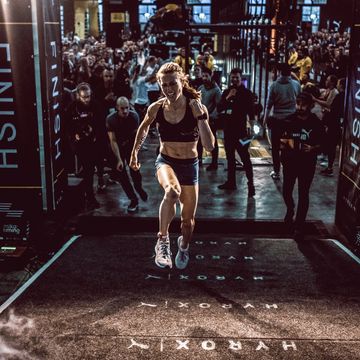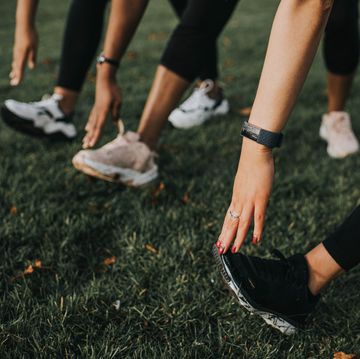Social media loves a good fitness trend, whether it’s the 12-3-30 workout or the 75 Hard Challenge. While some trends don’t provide the most sound advice, we’re here for those that promote cross-training and offer helpful information to runners.
Enter: the 3-2-8 workout program, which can help fine-tune your workouts off the road by incorporating strength work and low-impact core training into your schedule. Runner’s World investigated this hot new workout to bring you the basics, plus how to make it work for you.
What is the 3-2-8 challenge?
Natalie Rose, personal trainer, and barre and Pilates instructor, created the 3-2-8 program. She explains the basics on her website, Bodybybarre, where she also has a 12-week 3-2-8 challenge, as well as on TikTok and Instagram. Her many devotees proclaim its success on social media.
Specifically, 3-2-8 stands for:
- 3 strength-training sessions per week
- 2 Pilates or barre workouts per week
- 8,000 steps per day
While you could follow Rose’s program on her site, you also don’t have to. Choose your favourite strength workout, sign up for a Pilates or barre class (or use your favourite apps, like Peloton), and make the schedule work for you.
We spoke with three experts — an exercise physiologist, a barre teacher and runner, and a Pilates instructor and run coach — to bring you the pros and cons of the 3-2-8 workout program. While they had mixed reviews, they also had some solid advice for runners.
What are the benefits of 3-2-8?
‘Exercise programs have two purposes,’ Ed Coyle, PhD exercise physiologist and director of the Human Performance Laboratory at the University of Texas at Austin tells Runner’s World. ‘The first is to reduce the bad effects of inactivity and the second is to stimulate the good effects of cardio and muscle power.’
The 3-2-8 program, Coyle explains, will help to reduce the negative effects of inactivity – like diabetes and dementia – by encouraging people to take 8,000 steps a day.
In an email, Runner’s World asked Rose why she chose 8,000 steps as her goal. ‘8,000 steps per day supports stamina, cardiovascular fitness, and is less overwhelming than the usual 10,000 steps,’ she wrote.
While the average number of steps taken by most people varies by age and gender, in 2016, 103,383 employees took part in a physical activity challenge led by the Bipartisan Policy Center’s CEO Council on Health and Innovation. They averaged just 6,866 steps every day, although the researchers noted that this number reflected a challenge and, most likely, it’s probably actually more steps than the average most adults get during their days.
Coyle says his research has found that taking 5,500 steps every day is not enough to ward off the effects of inactivity, while 8,500 seems to be enough. (So you might want to go slightly higher than that 8,000 goal!)
You might think runs make up for inactivity, but that isn’t the case, says Coyle. Even if runners work up a sweat in the morning, if they sit or stand the rest of the day and take very few steps, they are still at risk for conditions like heart disease.
The negative effects of inactivity start occurring within hours and can even override a run. ‘Inactivity is not the same as lack of exercise,’ he explains. ‘When you’re inactive for too long, the bad things that happen can override the benefits of exercise.’
In addition to gaining the benefits of hitting a step count every day, the 3-2-8 program also encourages a decent amount of strength training. And strength training is beneficial to everyone, including runners.
Aside from its recommendation regarding aerobic activity, the Centers for Disease Control and Prevention also recommends that adults get two muscle-strengthening workouts in per week. This is in line with 3-2-8, which encourages even more than that.
Similarly, 3-2-8 includes Pilates and barre workouts. While these regimens aren’t the same thing (more about that later), there are proven benefits to both types of exercise.
While there aren’t many studies on barre specifically, the high-volume reps done to the point of fatigue in these classes may stimulate muscle growth and lead to positive health outcomes, according to research. Likewise, Pilates’ focus on core strength is beneficial to runners. A strong core has been shown to reduce the chance of injury, increase speed, and support running more efficiently. Plus, these two types of training offer a low-impact form of exercise, which is important for runners’ cross-training routines.
In fact, Coyle has used and recommends Pilates. ‘Pilates teaches you to engage your core so you move better. That’s an important part of fitness,’ he says.
What are the downsides of 3-2-8?
The first, and most serious, downfall of 3-2-8 is that people claim it will ‘reduce the symptoms of PCOS and inflammation.’ Exercise is absolutely good for health, but – aside from taking those 8,500 steps – no exercise program has been shown to be better than another in terms of disease reduction.
While research recommends 150 minutes of aerobic exercise per week for those who suffer from PCOS, the 3-2-8 program is not a prescription. Anytime you want to reduce symptoms of a condition, it’s best to work directly with your doctor to figure out the best treatment for you.
Also, while strength training is a part of 3-2-8, and Rose does offer some workouts on her site, it’s up to you to choose the workouts, as well as the moves, weights, reps, and progression of the program. Rose’s 12-week challenge does include these details, but as with most online programs, the recommendations are not personalized to your ability. ‘It’s unclear what you’re doing during the three weight sessions and you only benefit from strength training if there is a specificity to your training,’ Coyle says.
Also, although many people lump barre and Pilates together into a ‘mind-body’ category of exercise, the two workouts are different. Pilates moves engage the core muscles while lengthening the limbs. ‘Running compresses you and Pilates stretches you,’ Vickie Blate, certified Pilates instructor, USA Track and Field Level 2 Coach, and owner of On the Run Fitness & Pilates in Mount Dora, Florida, tells Runner’s World.
Meanwhile, the movements in barre focus on smaller ranges of motion and have less of a focus on core training (though it’s typically incorporated into classes). ‘You have to pay attention to each move and really notice each muscle,’ says Megan Leith, a runner and the founder of Barretend in Buffalo, New York.
Finally, while 3-2-8 encourages more movement in its daily step goal, it doesn’t actually include cardio exercise in its parameters, which is a downfall, Coyle says. The Centers for Disease Control and the NHS say adults should get 150 minutes of moderate activity or 75 minutes of intense activity every week. Doing this exercise can lower your risk of high blood pressure, type 2 diabetes, cardiovascular disease, stroke, certain cancers, and improve your mental health. But that’s where running comes into play!
How to adapt 3-2-8 for runners
If you run a few days a week, 3-2-8 can help you get on schedule with your cross-training and moving more throughout the day. To fit the recommended workouts into your schedule, Blate and Coyle say to strength train on run days if you’re doing speed or tempo runs. Your rest days should be truly restful, they add, meaning you don’t want to lift weights on your days off.
Because 3-2-8 includes three days of strength and two days of Pilates or barre, and fitting in five cross-training workouts into a run schedule can prove difficult, all the experts suggest swapping one strength-training workout with Pilates and barre, bringing those cross-training workouts down to three.
You can add those strength training sessions (which can last for anywhere from 20 to 60 minutes each) around your runs. Do hard strength training twice a week on the same day as hard runs, and Pilates and barre on active recovery days (while still making sure you get at least one solid full rest day per week).
Most importantly, to hit the 8,000-step goal of 3-2-8, Coyle says to break up the inactive parts of your day and evening with movement. That means getting up out of your chair more often throughout the day, between meetings, after a meal—whenever you can fit in a little activity.
..



